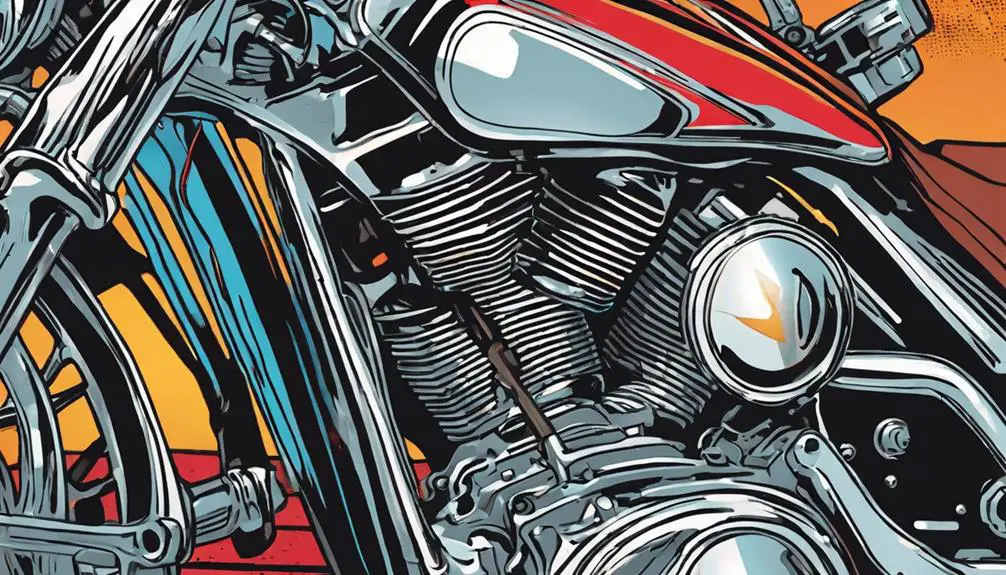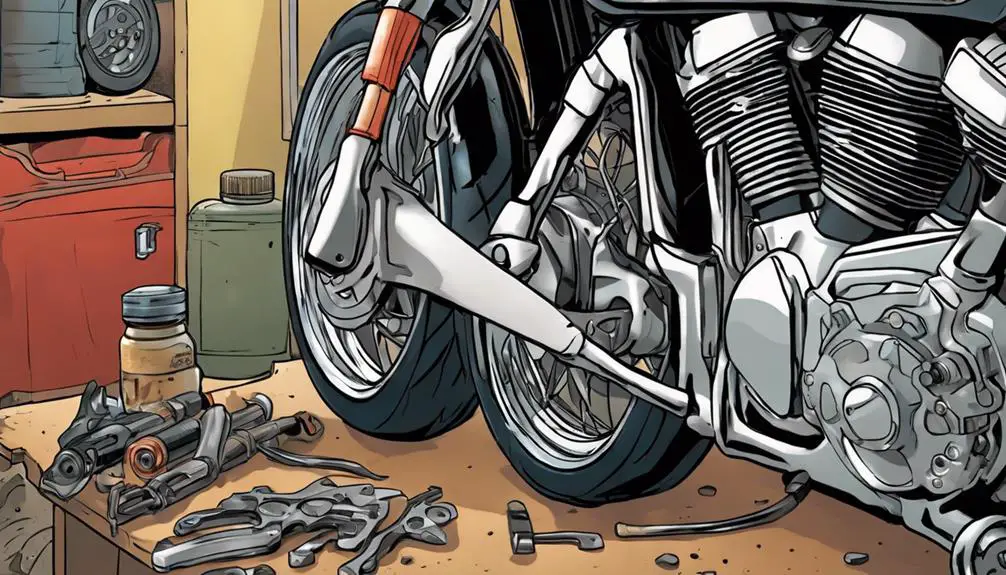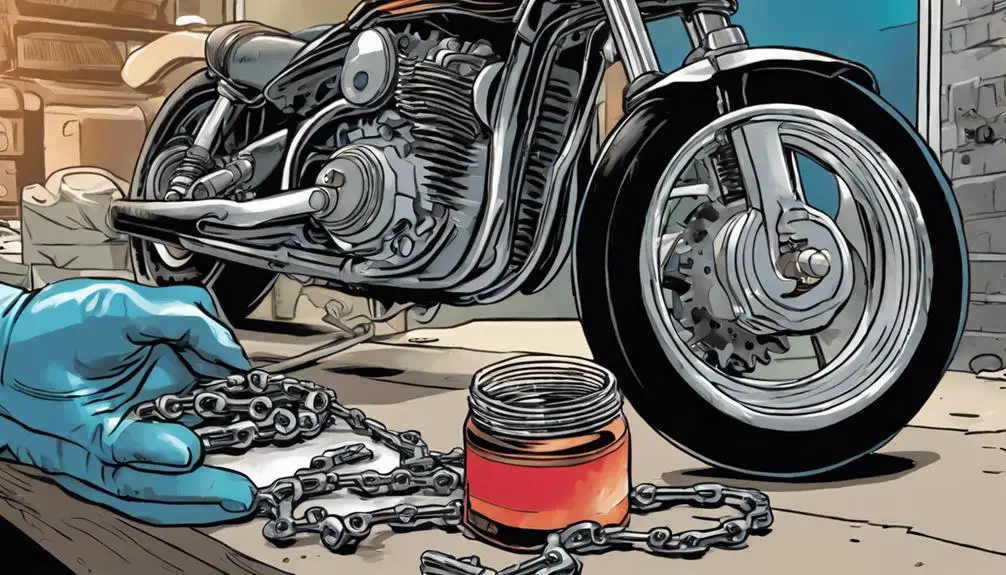Is your motorcycle truly ready for the road, or are you just hoping for the best? Keeping your bike in top shape is vital to prevent unexpected issues that can cut your ride short. By focusing on routine maintenance, you can enhance performance and guarantee safety. From oil changes to tire inspections, these five important tips will help you stay ahead of potential problems. What's the first step you should take to keep your motorcycle running smoothly?
Key Takeaways
- Perform regular oil changes every 3,000 to 5,000 miles to reduce friction and enhance engine performance.
- Regularly check and maintain tire pressure to ensure optimal handling and prevent blowouts.
- Inspect brake components frequently, including pads and fluid levels, for safe and effective braking.
- Conduct electrical system checks to prevent unexpected breakdowns; ensure battery, wiring, and fuses are in good condition.
Regular Oil Changes

Regular oil changes are essential for keeping your motorcycle's engine running smoothly and efficiently. You can't underestimate the power of fresh oil; it acts as a lifeblood, reducing friction and carrying away harmful contaminants.
When you change the oil regularly, you're not just preventing wear and tear; you're releasing your bike's full potential on the open road.
Always consult your motorcycle's manual for the recommended oil change intervals, but a good rule of thumb is every 3,000 to 5,000 miles. When you take control of this maintenance task, you empower yourself to extend your bike's lifespan and guarantee a thrilling ride.
Don't wait until the oil looks dirty or the engine starts sounding rough; proactive care is your best friend.
Make it a ritual. Gather your tools, feel the freedom in your hands, and enjoy the process. You'll gain a deeper connection with your machine and take pride in your work.
Plus, you'll feel the rush of liberation every time you twist the throttle and hear that engine purr, knowing you've given it the care it deserves. Your motorcycle is an extension of yourself—nurture it, and it'll reward you with unforgettable adventures.
Tire Maintenance Practices
Just as fresh oil keeps your engine running smoothly, proper tire maintenance is key to ensuring a safe and enjoyable ride on your motorcycle.
You need to keep a close eye on your tire pressure. Under-inflated tires can lead to poor handling, while over-inflated tires increase the risk of blowouts. Use a reliable gauge to check the pressure before every ride, and adjust as necessary.
Next, inspect your tires for any signs of wear or damage. Look for cracks, cuts, or uneven tread wear, as these can compromise your safety on the road. If you notice any of these issues, it's time to replace your tires.
Don't forget about tire rotation! Just like in a car, rotating your motorcycle tires helps promote even wear. Check your owner's manual for the recommended rotation schedule.
Brake System Checks

Checking your brake system frequently is essential for guaranteeing your motorcycle's safety and performance on the road. You wouldn't want anything holding you back from that exhilarating ride, right?
Start by inspecting the brake fluid level. Low fluid can indicate a leak, which can compromise your brakes considerably. Make certain the fluid is clean and topped up to the recommended levels.
Next, examine your brake pads. Worn pads can lead to reduced stopping power, risking your freedom on the open road. If you notice they're thin or unevenly worn, it's time to replace them.
Don't forget to check the rotors for any signs of warping or scoring, as these issues can affect braking efficiency.
Also, test your brake lever and pedal. They should feel firm and responsive, not spongy. If they do, you might need to bleed the brakes to remove any air in the lines.
Finally, verify your brake lights are functioning properly; you want to signal your intentions to others on the road.
Electrical System Inspection
Inspecting your motorcycle's electrical system is crucial for guaranteeing reliable performance and preventing unexpected breakdowns on your rides. Nothing feels worse than being stranded on the road, so taking a few moments to check your electrical components can lead to a more liberating experience on your bike.
Here are three key areas to inspect:
- Battery Condition: Check for corrosion on terminals and verify the battery is securely mounted. A weak battery can spell disaster, so don't overlook this crucial component.
- Wiring and Connections: Look for frayed wires or loose connections. A well-connected electrical system keeps your lights bright and your signals clear, enhancing your freedom to ride without fear.
- Fuses: Inspect your fuses for any signs of damage. A blown fuse can cut your ride short, but replacing it's quick and easy.
Chain and Sprocket Care

Maintaining your motorcycle's chain and sprockets is just as important as keeping the electrical system in top shape to guarantee smooth and efficient rides. A well-functioning chain and sprocket set not only enhances performance but also assures your freedom on the road remains uninterrupted.
Start by regularly inspecting your chain for wear and tightness. A loose chain can lead to poor handling and potential failure, while a worn chain can damage your sprockets. Aim for about an inch of slack—too much, and you risk slippage; too little, and you'll wear everything down faster.
Next, clean your chain often. Use a chain cleaner and a brush to remove dirt and grime. After cleaning, apply a quality chain lubricant to reduce friction and prolong life. Don't forget to lube the sprockets too; they need love too!
Lastly, keep an eye on alignment. Misalignment can cause uneven wear and lead to costly repairs. Adjust it if necessary, and check it regularly.
Embrace the freedom of the open road with a well-maintained chain and sprocket system, and you'll enjoy every ride without a hitch.
Frequently Asked Questions
How Often Should I Clean My Motorcycle After Riding?
After each ride, you should clean your motorcycle to maintain its performance and appearance. Dirt, grime, and road debris can cause wear over time.
If you ride frequently or in harsh conditions, consider cleaning it every week. For casual riders, a thorough wash every month works well.
Regular cleaning not only keeps your bike looking great but also allows you to spot any potential issues before they become bigger problems.
Enjoy the freedom of the ride!
What Tools Are Essential for Basic Motorcycle Maintenance?
Did you know that 70% of motorcycle breakdowns could be prevented with basic maintenance?
To keep your ride in top shape, you'll need a few essential tools. Grab a socket set, screwdrivers, and pliers for repairs. A tire pressure gauge and a chain cleaner are vital, too. Don't forget a multi-tool; it's handy for quick fixes.
Having these tools at your fingertips empowers you to tackle maintenance confidently and enjoy the freedom of the open road.
How Can I Improve My Motorcycle's Fuel Efficiency?
To improve your motorcycle's fuel efficiency, start by keeping your tires properly inflated and ensuring they're aligned.
Regularly change the oil and air filters to keep the engine running smoothly.
You can also lighten your load by removing unnecessary gear.
Riding at moderate speeds and avoiding rapid acceleration can greatly help too.
What Are Signs of a Failing Motorcycle Battery?
If you've ever found yourself struggling to start your bike, it might be a sign your battery's failing. You might notice dim headlights or a sluggish starter, especially on cold mornings.
If your bike's electrical components start flickering or malfunctioning, it's another red flag. Regularly checking your battery's age and condition can save you from a frustrating breakdown on the road.
Stay alert, and you'll keep your ride smooth and liberating.
How Do Weather Conditions Affect Motorcycle Maintenance?
Weather conditions can greatly affect your motorcycle's performance and maintenance needs.
Rain and humidity can lead to rust, while extreme heat might cause overheating or tire issues.
Cold weather can thicken fluids, making it harder for your bike to start.
You've gotta check the battery, tires, and fluids more frequently in varying climates.
Conclusion
By following these maintenance tips, you'll keep your motorcycle roaring like a lion on the open road.
Picture yourself gliding effortlessly through winding turns, the sun gleaming off a well-oiled engine, and the thrill of adventure at your fingertips.
Don't wait for that dreaded breakdown to remind you of the importance of upkeep.
Embrace these practices, and you'll not only enhance your ride but also guarantee countless miles of unforgettable journeys ahead.